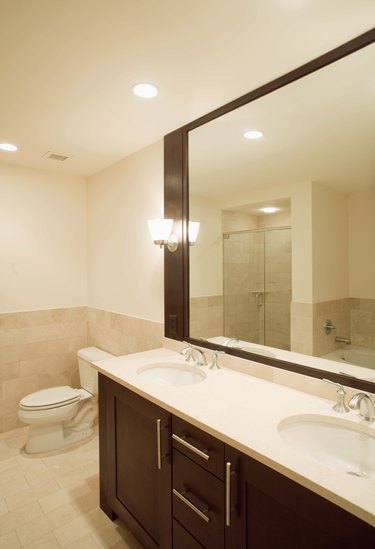
Painting over a mirror sounds a bit complicated at first, but understand that you are simply painting on glass, and craft supply stores carry a wide range of glass paints. You have a couple options for painting over a mirror, including covering the entire surface to repurpose a mirror or painting only a portion, which leaves you with a functional, decorative reflector.
Preparation
Video of the Day
Cleaning the mirror with standard glass cleaner such as Windex helps remove dust, dirt and oils so the paint adheres properly. Preparing the mirror in the location where you plan to paint the mirror reduces handling and ultimately prevents oils from your hands from reaching the clean glass.
Video of the Day
If the mirror has a frame, consider removing it prior to painting. This step allows you to paint all the way to the mirror's edges without transferring paint onto the frame. Once the paint dries, the frame is easy to assemble over the finished picture.
Paints
You have two paint options for painting glass: transparent and opaque. Transparent paints allow you to see through the paint, similar to stained glass. You cannot see a clear reflection looking through transparent paint into a mirror, but the transparent paint allows light to pass through resulting in a slightly backlit picture.
Opaque glass paints, on the other hand, are solid paints that, once applied, you cannot see through. Some opaque glass paints peak performance occurs after they are baked and cured because they are meant to adorn functional dishware and withstand microwave heating and dishwashers. Therefore, select air-dry glass acrylic paint for opaque results.
Application
Synthetic or natural fiber paintbrushes are suitable for applying paint over a mirror, and these tools are encouraged for freehand painting. Stencils do not require too much precision because the shape's outline is already sectioned off, which eliminates fine handwork at the image's edges. In this scenario, use stick-on stencils and a sponge for applying any type of paint. Opaque paints are easier to layer because their color is rich, so you can use a paint brush after a stencil application to adorn the image with delicate details.
Variations
Chalkboard paint and a magnetic primer glazed over a mirror yields a dual functional message board. Prepare the mirror with glass cleaner similar to preparing it for a picture and add two or three layers of magnetic primer. Once the coats dry, even with a couple layers of chalkboard paint, strong magnets hold securely to the mirror.
Two layers of chalkboard paint also create an even, rich black writing surface. Covering the new chalkboard's surface with a layer of chalk and then removing the chalk residue with a chalkboard eraser prepares the board for chalk writing.